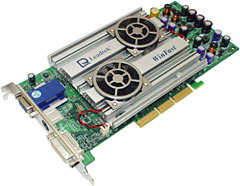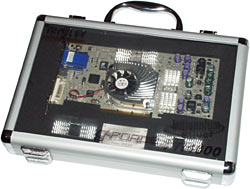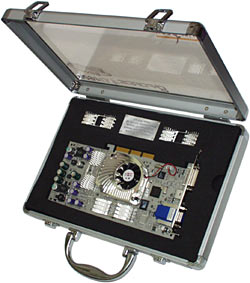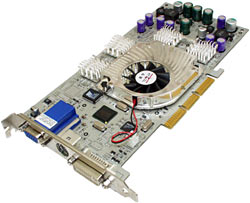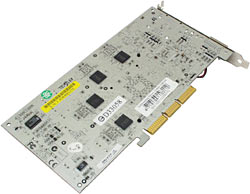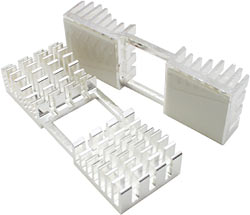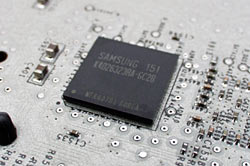
Triplex Millennium Silver GeForce4 Ti4600 video card
Review date: 23 May 2002. Last modified 03-Dec-2011.
Makers of Nvidia-chipset graphics cards have a problem.
All of their products are much the same.
Oh, there's plenty of difference between a GeForce2 MX200 board and a GeForce4 Ti4400. But all Ti4400s are pretty much the same as each other, just as are all MX200s.
The same chips, doing the same thing, at much the same speed. Some companies sell "pre-overclocked" cards that run at higher than the factory stock speed, but not a whole lot higher.
The components on different cards that use the same chipset are even, often, in exactly the same places, because many manufacturers stick to Nvidia's "reference" board design for each chipset.
Now, some cards may have more ins and outs than others; if you want DVI output or a TV input, then you'll need to buy a card that's got those connectors. And the bundled software that comes with the cards varies, too, though it's not often very thrilling. Nvidia's reference drivers usually work as well as, or better than, the drivers provided by the manufacturer.
Different cards may or may not be made in different factories. Cards for more than one manufacturer commonly are put together in the one place, but there are still occasional build quality issues.
But, basically, cards with a given chipset are the same darn thing, no matter whose name they're sold under.
This creates a brand differentiation nightmare for the video card companies. The bigger names don't want consumers to cotton on to the fact that a Fragrant Grasshopper board that comes in a cheap white box is the same thing as their rather more expensive product. The smaller names want to find some way to stand out from the crowd.
One way to do this - and it's about the best way there is - is via cosmetic extremism.
Take a card that's electrically much the same as everyone else's, and make it look outrageous.
Leadtek, for instance, are, like, totally down with this idea, dude. Their A250 GeForce4 boards all look like this, with a truly giant wrap-around heat sink. They probably weigh more than any previous PC graphics adapter; certainly more than anything else that isn't a full-length card.
Make a heat sink much bigger than this and it'll foul the next expansion slot - not to mention encourage the card to partially unplug itself, or snap off the AGP slot, if the computer's treated roughly. So Triplex had to think of a new angle.
I think we can safely say that they did.
The Triplex Millennium Silver Ti4600 comes in a little briefcase. With a clear front.
The case does not contain any battery-powered lights. But that wouldn't be hard to rectify.
The card itself has what looks to me like vanilla reference-board layout. But, like various other Triplex boards, it has a unique silver finish. It's not really shiny silver - more like a glistening grey. But it's unquestionably distinctive, and Triplex say it's useful, too, because it helps keep the card cool, rejects interference better, and is less polluting than the usual PCB finishes. Whether any of this is true, I don't know. It does look nifty, though, and it makes this card obviously attractive to the case-modding crowd.
And, at $AU693 including Australian delivery (it was $AU825 when I first put this review up, but prices have fallen now), the Millennium Silver Ti4600 isn't even particularly expensive, compared with other Ti4600s. Leadtek's Ti4600 isn't the priciest Ti4600 out there, but it costs more than this one. And it doesn't come with a natty little case.
There is, of course, no way to argue that the Triplex card's case is a useful thing. If video cards were objects that people carried around like pool cues, there'd be some point to it. But they aren't, and there isn't.
OK, it might keep the cards safer in transit than the usual sort of packaging, but I doubt it. Video cards aren't shipped internationally in air-filled retail boxes, you know.
The case is not briefcase-sized; if you ask me, it qualifies as "dainty". Its internal dimensions are only about 190 by 290 by 35mm, so you can just about fit two sandwiches in it, side by side, if you take the card-packing foam out.
The back of the Millennium Silver Ti4600 has bare RAM chips, without the shiny heat sinks that adorn the matching four chips on the other side. This is just because the card wouldn't fit in the case properly with its full complement of heat sinks attached, though...
...and you get the other two sinks, complete with thermal adhesive pads, in the case.
The RAM heat sinks on this and every other current PC video card are, by the way, pretty much purely cosmetic. RAM, even ultra-fast video RAM, just doesn't emit enough heat for the sinks to make a significant difference. Nvidia's non-retail reference GeForce4 Ti cards don't come with RAM-sinks, and yet they overclock only slightly worse than the most ludicrously metal-bedecked retail boards, including the Leadtek I've got in this computer at the moment.
But hey, the sinks are shiny. They don't do any harm. Unless you try to peel them off, in which case you may find that the adhesive is stronger than the connection the Ball Grid Array memory chips have to their circuit board.
On the subject of which - here's one of the chips.
It's a Samsung K4D26323RA-GC2B.
Or maybe -GC28.
But that looks like a B to me.
The reason why this is confusing is that Samsung don't list either a GC2B or a GC28 on their site. The current consensus is that GC2B/8 means the same as the GC2A suffix that is listed on the Samsung site. That indicates their top-spec 2.8 nanosecond (350MHz) DDR memory, good for 700MHz DDR-doubled operation, or more if you push it using an overclocking utility. The "Clock Frequencies" sliders provided in the standard Nvidia drivers top out at 690MHz for RAM speed.
The standard factory core and RAM speeds for Ti4600 cards are 300 and 650MHz, respectively, and that's how fast the Triplex card runs by default.
This board has the other standard features for a three-connector GeForce4 Ti, too. Y/C (S-Video) TV input and output, for a start; there's only one mini-DIN Y/C connector, but you get a Y-adaptor cable with the card, so you can connect input and output leads simultaneously. You can't use them simultaneously, but at least you don't have to swap plugs. There's also the usual single Y/C lead, of medium quality and length.
The other two connectors on the back of the card are the normal 15 pin VGA output, and a DVI-I connector.
As with all dual-connector GeForce4 Ti cards, this one can drive two monitors at once, using Nvidia's better-than-it-used-to-be Nview system. The DVI-I output has pins that carry a standard RGB analogue signal as well as the digital signal that DVI monitors use, so you can plug a DVI flat panel monitor straight into it, or buy an optional adapter to connect another plain analog display. DVI-D connectors don't have the analogue pins.
Along with the card you get a driver CD (the card I got to review also had a CD-R with newer drivers on it - I'd just use the reference drivers if I were you), and two more bundled discs. There's the ubiquitous but still perfectly good Cyberlink PowerDVD, and also Cyberlink's PowerDirector 2.0 DE, a video editing package to go with the card's video input.
Crunching numbers
Be GeForce4 Ti4600 standards, this is a perfectly good card, and certainly not one that'll be mistaken for any other company's product.
The question is - do you need anybody's Ti4600, if you've decided to purchase a "full" GeForce4 (as opposed to the GeForce4 MX, which is great value for money, but doesn't actually even manage a full GeForce3 feature set)?
Get a Ti4600 card with 2.8ns RAM on it and you've got the most overclockable GeForce4 there is. The difference between the stock 650MHz RAM speed and the 700MHz that the RAM's rated to manage, though, is less than 8%; its impact on any real world task won't be noticeable.
If you manage to wind the RAM all the way up to 750MHz (which you may be able to do), then you've got a better than 15% overclock, which you might just be able to notice. But it's still nothing worth getting hot and bothered about.
The core speed of a randomly chosen GeForce4 card is likely to be boostable by an even more underwhelming amount. 320MHz seems likely to be attainable without stability problems, but that's less than a 7% overclock. The chunkiness of the cooler on the main chip seems to make close to no difference to its overclockability.
A 7% core overclock plus a 15% RAM overclock may get you 6% better frame rates.
Whoopty-doo.
People seem to care about this small a speed difference, though. You can tell, because they pay a hefty premium for Ti4600 cards, despite the fact that they're not much faster than the cheaper GeForce4 Tis.
The cheapest in the full GeForce4 range is the 64Mb GeForce4 Ti4200, yours for less than $AU341 for a version with DDR memory; I review that card here. It has factory core and RAM clock speeds of 250 and 550MHz, respectively.
The Ti4600 is clocked 20% and 30% faster, respectively.
Which adds up to an actual performance advantage, assuming you don't need 128Mb of video memory (and you probably don't) of between 10% and 15%. You might crack 20% if you're doing something that really leans on the RAM. 1600 by 1200 with FSAA, say, on the 30 inch monitor you'll need if you want to be able to see much of a difference from FSAA when there are 1,920,000 pixels in every frame.
The 128Mb Ti4200 has a 444MHz factory RAM speed, and may or may not be reliably overclockable to 500MHz. But the Ti4400 cards you can buy all over the place right now have 128Mb of RAM, with factory core and RAM speeds of 275 and 550MHz, respectively.
Which, for those who're a little slow on the uptake, means they're even closer to Ti4600 speed. The 4600 probably won't be able to manage better than 1.1 times the frame rate of a 4400 for anything, assuming you don't cheat by overclocking the 4600 and leaving the 4400 at stock speed.
At $AU693 delivered, the Triplex isn't an expensive Ti4600 card, particularly if you get a kick out of its fancy trimmings. But you can have a Leadtek A250 Ti4400 card (with, I remind you, The World's Most Ridiculous Graphics Adapter Heat Sink), for $AU555 delivered, and the speed's basically the same. The 128Mb Ti4200 cards are $AU412.50.
So if you're hunting a stylin' Ti4600 with which to adorn your show-off LAN party PC, Triplex's offering completely fits the bill. But I'd go for a 4200 or 4400 if I were you.
If you're in love with the Triplex silver PCB, bear in mind that they make a 4400 model that looks just like the 4600, though it doesn't seem to be available here in Australia. The 4200 model looks different, but it's still silver; check it out here.
The Millennium Silver Ti4600 is a perfectly good piece of gear. But I'm sticking with my heavy metal Leadtek Ti4400.
